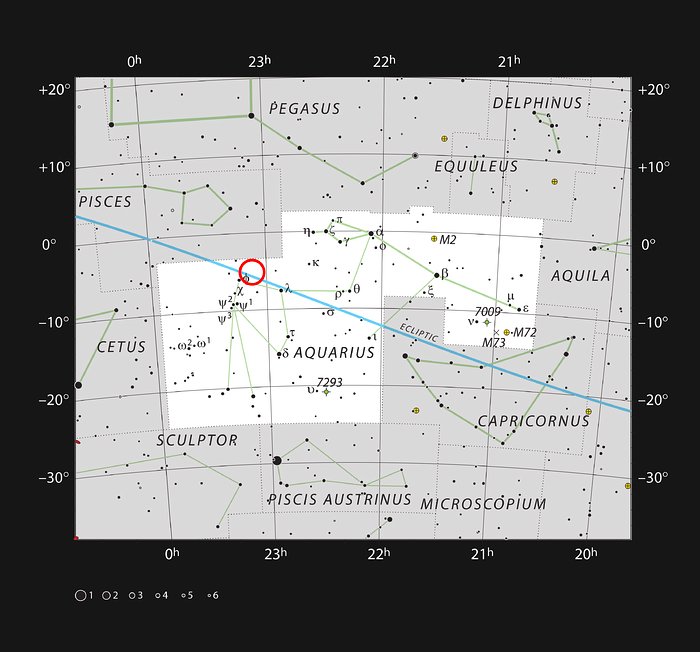
This artist’s impression shows an imagined view from the surface one of the three planets orbiting an ultracool dwarf star just 40 light-years from Earth. In this view one of the inner planets is seen in transit across the disc of its tiny and dim parent star. Credit: ESO/M. Kornmesser
These worlds have sizes and temps similar to Venus and Earth and are the best targets found so far for the search for life outside the Solar System. They are the first planets ever discovered around such a tiny and dim star. A team used the Belgian TRAPPIST telescope to observe the star 2MASS J23062928-0502285 aka TRAPPIST-1. They found that this dim and cool star faded slightly at regular intervals, indicating several objects were passing between the star and Earth ie 3 planets with similar sizes to the Earth were present.

In this view one of the inner planets is seen in transit across the disc of its tiny and dim parent star. Credit: ESO/M. Kornmesser
TRAPPIST-1 is much cooler and redder than the Sun and barely larger than Jupiter. Such stars are both very common in the Milky Way and very long-lived, but this is the first time that planets have been found around one of them. Despite being so close to the Earth, this star is too dim and too red to be seen with the naked eye or even visually with a large amateur telescope. It lies in the constellation of Aquarius (The Water Carrier).
Michaël Gillon said: “Why are we trying to detect Earth-like planets around the smallest and coolest stars in the solar neighbourhood? The reason is simple: systems around these tiny stars are the only places where we can detect life on an Earth-sized exoplanet with our current technology. So if we want to find life elsewhere in the Universe, this is where we should start to look.”

In this view one of the inner planets is seen in transit across the disc of its tiny and dim parent star. Credit: ESO/M. Kornmesser/N. Risinger
Astronomers will search for signs of life by studying the effect that the atmosphere of a transiting planet has on the light reaching Earth. For Earth-sized planets orbiting most stars this tiny effect is swamped by the brilliance of the starlight. Only for the case of faint red ultra-cool dwarf stars – like TRAPPIST-1 – is this effect big enough to be detected. Follow-up observations with larger telescopes, including the HAWK-I instrument on ESO’s 8m VLT have shown that the planets orbiting TRAPPIST-1 have sizes very similar to that of Earth. 2 of the planets have orbital periods of about 1.5 days and 2.4 days respectively, and the third planet has a less well determined period in the range 4.5 to 73 days.
“With such short orbital periods, the planets are between 20 and 100 times closer to their star than the Earth to the Sun. The structure of this planetary system is much more similar in scale to the system of Jupiter’s moons than to that of the Solar System,” explains Michaël Gillon.

This chart shows the naked eye stars visible on a clear dark night in the sprawling constellation of Aquarius (The Water Carrier). The position of the faint and very red ultracool dwarf star TRAPPIST-1 is marked. Although it is relatively close to the Sun it is very faint and not visible in small telescopes. Credit: ESO/IAU and Sky & Telescope
Although they orbit very close to their host dwarf star, the inner two planets only receive 4X and 2X, respectively, the amount of radiation received by the Earth, because their star is much fainter than the Sun. That puts them closer to the star than the habitable zone for this system, although it is still possible that they possess habitable regions on their surfaces. The third, outer, planet’s orbit is not yet well known, but it probably receives less radiation than the Earth does, but may still lie within the habitable zone.

This picture shows the Sun and the ultracool dwarf star TRAPPIST-1 to scale. The faint star has only 11% of the diameter of the sun and is much redder in colour. Credit: ESO
“Thanks to several giant telescopes currently under construction, including ESO’s E-ELT and the NASA/ESA/CSA James Webb Space Telescope due to launch for 2018, we will soon be able to study the atmospheric composition of these planets and to explore them first for water, then for traces of biological activity. That’s a giant step in the search for life in the Universe,” concludes Julien de Wit,MIT.
This work opens up a new direction for exoplanet hunting, as around 15% of the stars near to the Sun are ultra-cool dwarf stars, and it also serves to highlight that the search for exoplanets has now entered the realm of potentially habitable cousins of the Earth. The TRAPPIST survey is a prototype for a more ambitious project called SPECULOOS that will be installed at ESO’s Paranal Observatory. http://www.eso.org/public/news/eso1615/







Recent Comments